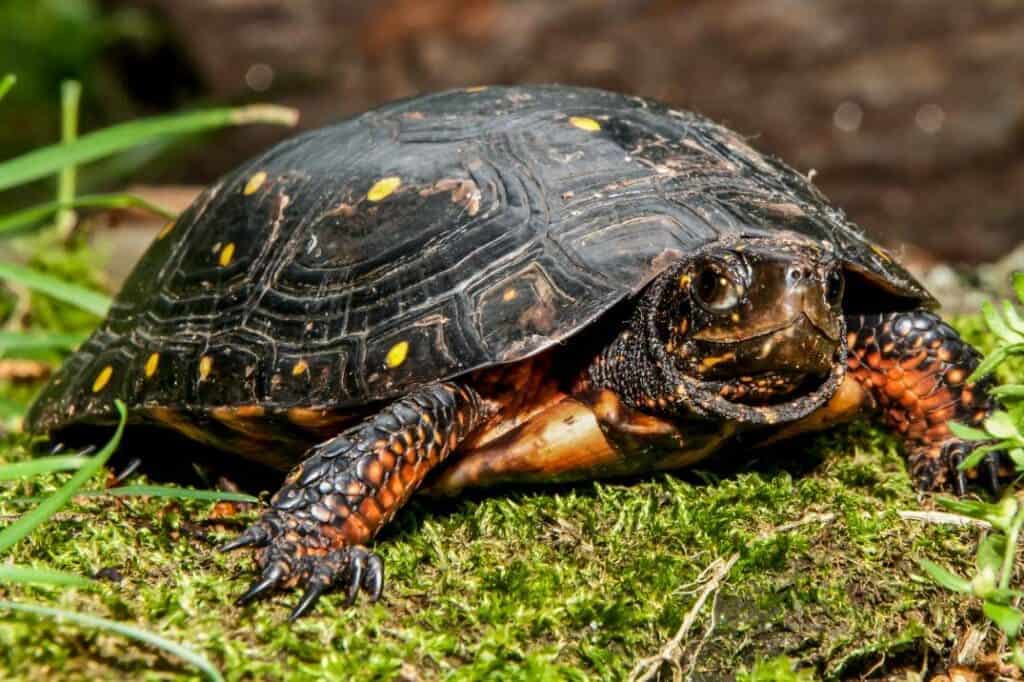A pretty little thing, the Spotted Turtle not only stands out because of its coloring, but is perky and durable too!
These are some of North America’s most exciting turtles. The Spotted Turtles are personable and alert and beautifully marked in a variety of colors and adornment. Spotted Turtles have a shiny black shell covered with yellow spots. Though available as wild-collected specimens in the past, these turtles are now protected throughout their range.
Spotted Turtles make great pets. They are a nice, small size and easily managed by most turtle keepers. They are wanderers, shy and alert, plopping into the water or racing under a shelter at the approach of their keeper. They will soon become tame and though they dive off into the water or run under a shelter, will quickly reappear to see if any food has been offered.
- For more information see: Selecting and Caring for Your Turtle or Tortoise
Scientific Classification
| Kingdom: | Animalia |
| Phylum: | Chordata |
| Class: | Reptilia |
| Order: | Testudines |
| Family: | Emydidae |
| Genus: | Clemmys |
| Species: | guttata |
Distribution:
The Spotted Turtle Clemmys guttata was described by Schneider in 1792, originally as Testudo guttata. They are found in the United States, ranging from southern Maine west to extreme northeastern Illinois and south along the coastal plain to northern Florida.
This turtle is one of the four recognized species of the Clemmys genus, all of which are found in the United States and southern Canada. The other three are:
- Western Pond turtle Clemmys marmorata
- Wood Turtle Clemmys insculpta
- Bog turtle Clemmys muhlenbergii
The genus Clemmys has received much scrutiny from taxonomists and several have suggested splitting Clemmys into two or three genera. These changes are speculative and so for now we are using the traditional and currently accepted Clemmys until the taxonomic confusion can be sorted out.
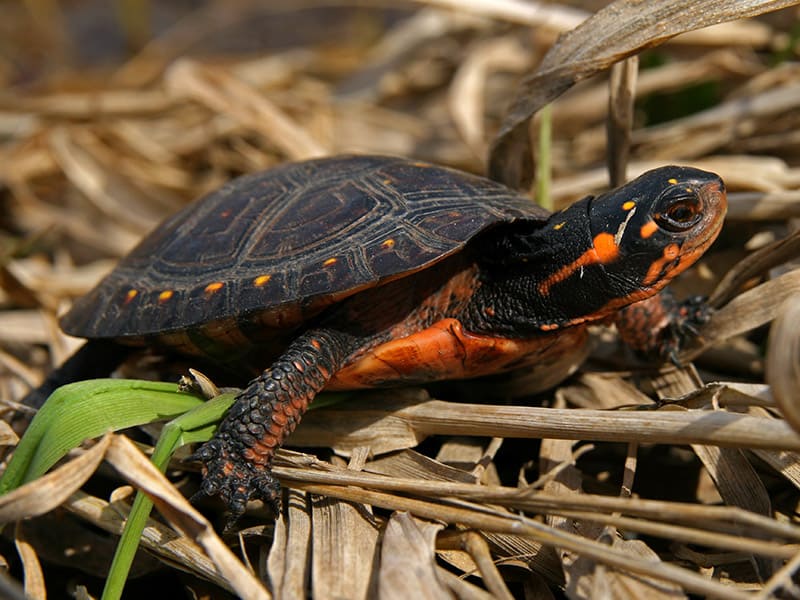
Status
This turtle is listed on the IUCN Red List of Threatened Species: VU – vulnerable, and listed on CITES: Appendix II, and listed by the Committee on the Status of Endangered Wildlife in Canada (COSEWIC): Endangered.
Description
As their name implies, Spotted Turtles have beautiful carapaces that are overall black with a few, to many scattered yellow spots. Their faces are adorned with splotches of orange and yellow. Adults, especially males, have beautiful orange coloration on the legs. Adults will reach an overall length of approximately 5″ (12 cm).
Care and Feeding
Spotted Turtles eagerly accept commercial turtle food but also enjoy earthworms, wax worms, crickets, and lean strips of beef. You can also offer Clemmys (as well as the Diamondback Terrapins) an aquatic turtle mix of four or five commercially available turtle pellets. In outdoor pens, they will eat commercial turtle food, forage for invertebrates, and nibble on a variety of aquatic plants including duckweed and Azolla.
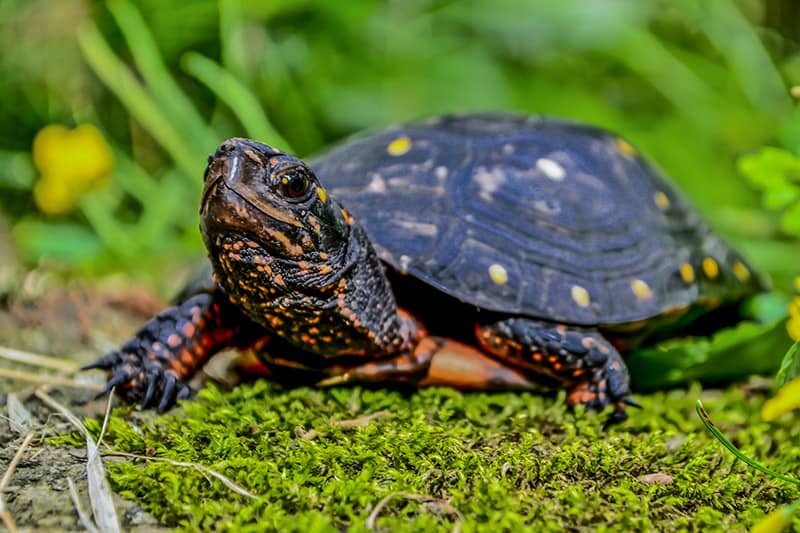
Environment
There are several successful enclosures for keeping and breeding this group of turtles. Spotted Turtles thrive in these environments as long as they have plenty of clean water. Their water should be warm (76{deg} to 78{deg} F) and they should have access to lots of live plants that offer hiding spaces and security.
Outdoors
A typical outside enclosure, a rectangular pen, can be created by stacking two layers of railroad ties. A good-sized pen measures 10′ x 10′ and is approximately 2′ tall. Make sure that it is partially shaded by surrounding trees or shrubs or a man-made structure during part of the day.
Inside of this enclosure place a sunken tub that measures roughly 36″w x 60″l x 10″deep. This sunken tub serves as the water portion of the enclosure. Add chlorine-free water, driftwood, and aquatic plants. You can also add a cloth bag or the leg of a pair of panty hose full of peat moss into the water initially to help the pH. Provide a series of steps within both ends of the water area so the turtles can easily climb out.
At one end of the enclosure add a deep (10″) layer of a mixture of ½ peat moss and ½ damp river sand, this provides an egg-laying area. The other end of the enclosure can be heavily planted with bog and marginal plants such as wild iris, papyrus, cattails, and taro. Leave an 18″ x 18″ area along one side with soil only; no plants; this area provides a feeding area.
This enclosure has proven to be very successful for keeping and breeding Spotted Turtles and Wood Turtles at the Turtle and Tortoise Preservation Group facilities.
Indoors
Spotted Turtles can be set up in larger tubs indoors, 48″ w x 84″ l x 24″ deep. Winter or “resting” enclosures such as these are not as elaborate as the outdoor enclosures for ease of maintenance and for watching the turtles’ behavior and condition more closely during this time.
Substrate once again consists of ½ peat and ½ damp sand, but first add about 10″ of pea gravel to the bottom of the tub to allow some drainage for this especially damp system. Place a cat litter pan or cement-mixing tub inside to create a water area. A top layer of cypress mulch placed over 75% of the environment will aid in holding in the moisture. Add shade-loving plants along with palm fronds and dry leaves to provide more cover. Sheets of bark and large slabs of slate resting sturdily on bricks will also act as cover for the more shy turtles.
Aquatic Environments
Spotted Turtles can also be kept in a more aquatic enclosure. Some keepers keep them with musk turtles and other turtles in an aquatic environment. They do bask and are often found out on the basking sites or resting at the edge of the pond or on driftwood logs, but seem happy to live in this aquatic situation.
Take care with this type of enclosure to ensure that the sides of the water portion are sloped to allow the turtles to climb out easily. There have been cases of females being drowned by the weight of the males on their backs during mating. The sloped edges allow the female to drag herself and the accompanying male out to land or to an area where she is not held down underwater.
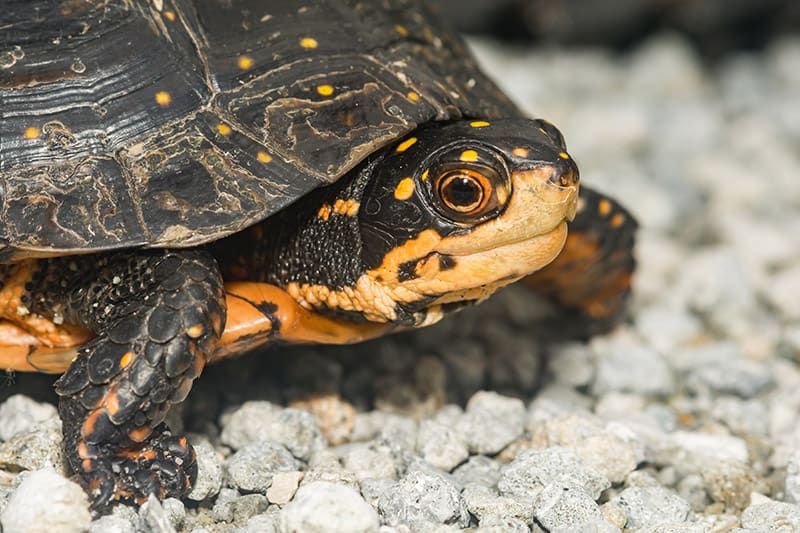
Handling
Captive-hatched specimens, as always, are the best to keep as pets and most will become so docile that they can easily be fed by hand. These and all aquatic turtles should be considered wonderful display animals and not pets that are easily held.
Breeding
These turtles can all be prolific in captivity. Cooling, even minimal cooling during the winter, is used to spark reproduction in all four species, especially specimens from northern areas. Spotted Turtles can lay two to three clutches of four eggs each year. A large female Wood Turtle will typically lay one or two clutches of eight eggs. Bog Turtles typically lay one clutch of four eggs and Western Pond Turtles lay two or three clutches of five to eight eggs each year.
The babies can be set up in a 20-gallon long aquarium. They are hardy and grow quickly when offered a healthy diet featuring a variety of feeder insects (redworms, crickets, and wax worms.), live guppies, and commercial pelleted food. Reptomin®, with its worm-like shape, seems to be an early favorite.
Ailments / Health Problems
Health problems and shell abnormalities can arise from poor nutrition. Fungal infections attach to abrasions. Swollen irritated eyes develop when water quality is poor, especially when the pH of the environment is too high. If kept for some time outdoors in direct sunlight and in clean water, these turtles thrive.
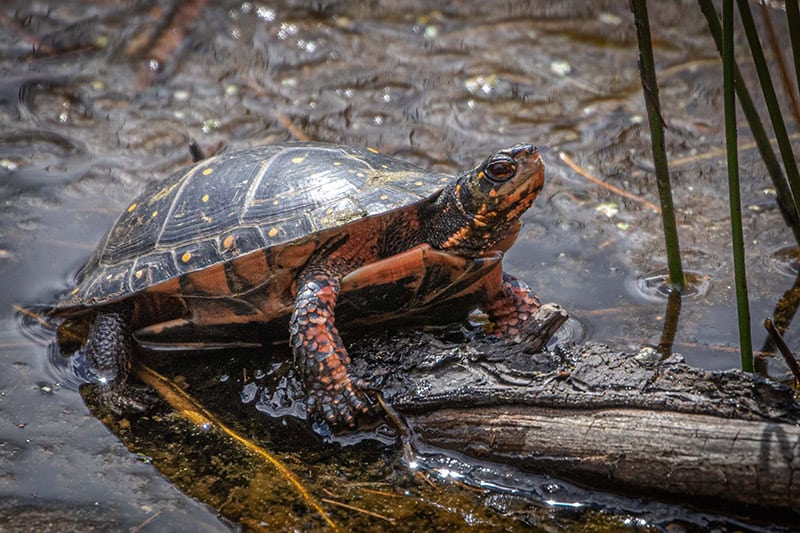
Availability
All four of the recognized Clemmys turtles were once common in the pet industry, but are seen less frequently today due to their protected status. They are all being bred in captivity, however their protected status varies from state to state. Be sure to contact the fish and game commissioners in your state to find out what regulations apply in your area. Many states allow keeping these turtles, but do not allow commercialization.
Featured Image Credit: Jay Ondreicka, Shutterstock
